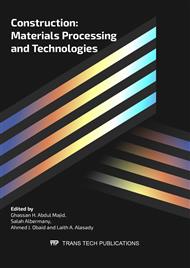[1]
S.M. Al-Salem, P. Lettieri, J. Baeyens, Recycling and recovery routes of plastic solid waste (PSW): A review, Waste Management. 29 (2009) 2625–2643.
DOI: 10.1016/j.wasman.2009.06.004
Google Scholar
[2]
J. Thorneycroft , J.P. Savoikar, R.J. Ball, Performance of structural concrete with recycled plastic waste as a partial replacement for sand, Construction and Building Materials. 161 (2018) 63–69.
DOI: 10.1016/j.conbuildmat.2017.11.127
Google Scholar
[3]
A. Badache, A.S. Benosman, Y. Senhadji, M. Mouli, Thermo-physical and mechanical characteristics of sand-based lightweight composite mortars with recycled high-density polyethylene (HDPE), Construction and Building Materials. 163 (2018) 40 –52.
DOI: 10.1016/j.conbuildmat.2017.12.069
Google Scholar
[4]
A.I. Al-Hadithi, M.F. Alani, The importance of adding waste plastics on the properties of high performance concrete, Published in Proceedings of the Institution of Civil Engineers - Waste and Resource Management. 171 (2018) 1-65.
DOI: 10.1680/jwarm.17.00040
Google Scholar
[5]
M.M. Al-Ani, A.I. Al-Hadithi, M.H. Mohammed, Production and optimization of eco-efficient self-compacting concrete SCC with limestone and PET. Construction and Building Materials. 197 (2019) 734–746.
DOI: 10.1016/j.conbuildmat.2018.11.189
Google Scholar
[6]
L.A. Zurauskas, J. Keriené, The effect of foam polystyrene granules on cement composites properties, Cement Concr. Compos. 41(2005) 7-27.
Google Scholar
[7]
Z. Ismail, E. Al-Hashmi, Use of waste plastic in concrete mixture as aggregate replacement, Waste Manage. 204 (2008) 7-28.
DOI: 10.1016/j.wasman.2007.08.023
Google Scholar
[8]
P. Panyakapo, M. Panyakapo, Reuse of thermosetting plastic waste for lightweight concrete. Waste Manage. 1581(2008) 8-28.
DOI: 10.1016/j.wasman.2007.08.006
Google Scholar
[9]
I. Yadav, Laboratory investigations of the properties of the concrete containing recycled plastic aggregates. IN: Master of engineering in structural engineering. Thapar University, Patiala, India; (2008).
Google Scholar
[10]
H. Dweik, M. Ziara, M. Hadidoun, Enhancing concrete strength and thermal insulation using thermoset plastic waste. Int. J. Polym. Mater. 635 (2008) 47-56.
DOI: 10.1080/00914030701551089
Google Scholar
[11]
P. Mounanga, W. Gbongbon, P. Poullain, P. Turcry. Proportioning and characterization of lightweight concrete mixtures made with rigid polyurethane foam wastes. Cem. Concr. Compos. 806 (2008)14-30.
DOI: 10.1016/j.cemconcomp.2008.06.007
Google Scholar
[12]
A. Fraj, M. Kismi, P. Mounanga, Valorization of coarse rigid polyurethane foam waste in lightweight aggregate concrete. Constr. Build. Mater. 1069 (2010) 24-77.
DOI: 10.1016/j.conbuildmat.2009.11.010
Google Scholar
[13]
A. Alhozaimy, M. Shannag, Performance of concretes reinforced with recycled plastic fibers. Mag. Concr. Res. 293 (2009) 8-61.
DOI: 10.1680/macr.2008.00053
Google Scholar
[14]
S. Kou, G. Lee, C. Poon, W. Lai, Properties of lightweight aggregate concrete prepared with PVC granules derived from scraped PVC pipes. Waste Manage. 621 (2009) 8-29.
DOI: 10.1016/j.wasman.2008.06.014
Google Scholar
[15]
Y. Wang, S. Backer, V. Li, An experimental study of synthetic fiber reinforced cementitious composites. J. Mater Science. 281(1987) 22-91.
Google Scholar
[16]
A. Jelidi, Conception d'un materiau composite a matrice cimentaire reinforce par des fibres de polyester. PhD dissertation, Inst. Nat. Sci. Appl., Lyon, France. (1991).
Google Scholar
[17]
V. Houget, Dês caracteristiques mecaniques et physico-chimiques de composites ciments-fibres organiques. PhD dissertation, Inst. Nat. Sci. Appl., Lyon, France. (1992).
Google Scholar
[18]
R. Cairns, H. Kew, M. Kenny, The use of recycled rubber tires in concrete construction. Final Report. The Onyx Environmental Trust, University of Strathclyde, Glasgow. (2004).
Google Scholar
[19]
H. Purnomo, G. Pamudji, M. Satim, Influence of aggregates to concrete compressive strength uncoated and coated plastic waste coarse, MATEC Web of Conferences101, SICEST, 01016. (2017).
DOI: 10.1051/matecconf/201710101016
Google Scholar
[20]
A.I. Abdulla, S.H. Ahmed, Effect of rubber treated by acidic solution on some mechanical properties of rubberize cement mortar, Engineering College, University of Tikrit, Tikrit. 29(2011) 2793- 2806.
Google Scholar
[21]
K.B. Najim, Determination and enhancement of mechanical and thermo-physical behaviour of crumb rubber-modified structural concrete, Thesis submitted to the University of Nottingham for the degree of Doctor of Philosophy. (2012).
Google Scholar
[22]
Q.W. Ma, J.C. Yue, Effect on mechanical properties of rubberized concrete due to pretreatment of waste tire rubber with NaOH, Applied Mechanics and Materials. 357-360 (2013) 897-904.
DOI: 10.4028/www.scientific.net/amm.357-360.897
Google Scholar
[23]
O. Onuaguluchi, Effects of surface pre-coating and silica fume on crumb rubber-cement matrix interface and cement mortar properties, Journal of cleaner Production. 104 (2015) 339-345.
DOI: 10.1016/j.jclepro.2015.04.116
Google Scholar
[24]
R. Sharma, P. P. Bansal, Use of different forms of waste plastic in concrete – a review, Journal of Cleaner Production. 10.1016/j.jclepro.08.042. (2015).
Google Scholar
[25]
A. Mohammed, T.K. Ali, N.M. Rajab, N.N. Hilal, Mechanical properties of concrete and mortar containing low density polyethylene waste particles as fine aggregate. Journal of Materials and Engineering Structures (JMES). 7 (2020) 57-72.
Google Scholar
[26]
ASTM C 109/C 109M, Test method for compressive strength of hydraulic cement mortars (Using 2- in. or 50-mm cube specimens). (2008).
DOI: 10.1520/c0109_c0109m-20
Google Scholar
[27]
ASTMC348, Standard test method for flexural strength of hydraulic-cement mortars. (2008).
Google Scholar
[28]
ASTM C 642-06, Standard test method for density, absorption and voids in hardened concrete, United States Am. Soc. Test Mater. USA, 2008, p.11–13.
Google Scholar


